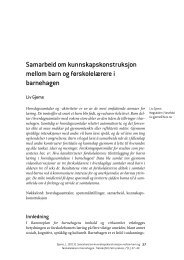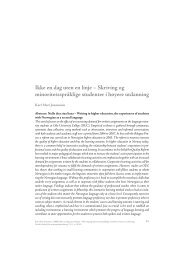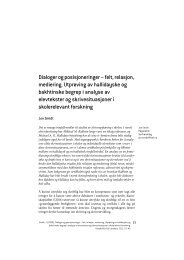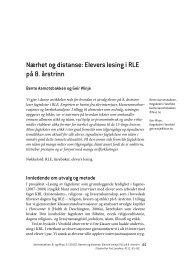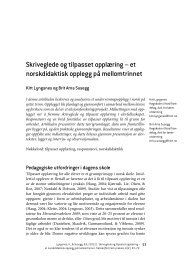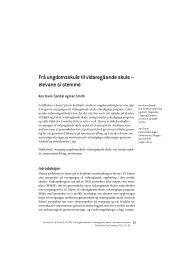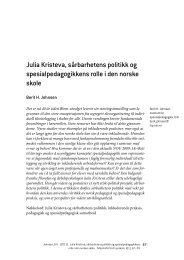AN ESSAY ON SPIRITUALITY OF HOMO LUDENS URBANUS
AN ESSAY ON SPIRITUALITY OF HOMO LUDENS URBANUS
AN ESSAY ON SPIRITUALITY OF HOMO LUDENS URBANUS
- No tags were found...
Create successful ePaper yourself
Turn your PDF publications into a flip-book with our unique Google optimized e-Paper software.
Nordic Journal of Religion and Society (2009), 22 (1): 1–14Pasi Mäenpää<strong>AN</strong> <strong>ESSAY</strong> <strong>ON</strong> <strong>SPIRITUALITY</strong> <strong>OF</strong> <strong>HOMO</strong><strong>LUDENS</strong> URB<strong>AN</strong>USAbstractThis essay discusses some aspects of the culture of urban consumption and how they could makesense or explain recent changes of religiosity in Finland. Shopping can be approached as a significantpractise of orientating oneself in society both materially, symbolically and socially. Themain argument is that this mental orientation originating from modern urbanity is apt to becomegeneralised ethics of urban people of today with spiritual and religious dimensions. The aspectsdiscussed include aleatoriness and serendipity, prolonged youth, urban sociability, inner experiences,authenticity of identity, animation of life, energetic flow, and mimetic self-relation. Allthese refer to constitutive dimensions of the human realm of play and playfulness. The theorisingof play and games holds the theoretical framework for the analysis. The result is an analysis ofthe spirituality of the human character Homo ludens urbanus.Key words: urban culture, consumption, religiosity, spiritualityIntroductionThe Latin term Homo ludens urbanus in the title refers to Dutch historian Johan Huizingaand his classic book Homo Ludens (1938). By adding a word urbanus I seek tospecify and contextualise the characterisation to the modern city life. Huizinga discussesthe importance of the play element of culture and society. He makes it clear inthe foreword of his book that he means the play element of culture, and not the playelement in culture. For him, play is primary to the culture. Animals play, though theyhave no culture – nor religion.Another classical theorist of play and games is Roger Caillois’ Man, Play and Games(1961). Also Caillois analysed play as a principle of creating and constituting culturethroughaction. For both, play is not only a leftover from ancient times previous to thecivilization, but a constant form of human action taking place beside or inside the «serious»reality of all times. Walter Benjamin shared the same view when writing of the significanceof mimesis in modern, urbanized world. Georg Simmel (1964a) argued thatpeople’s sociability is autotelic or self-purposeful and thus playful action. Simmel wrote,1
Nordic Journal of Religion and Society 22:1that «The more profound, double sense of ‘social game’ is that not only the game isplayed in a society (…) but that, with its help, people actually ‘play’ society» (1964a: 50).For Simmel playfulness is a society forming element.These are the theorists I utilise when approaching the modern urban consumer cultureand looking for its connections to today’s religiousness and spirituality. This essay isbased on my doctoral dissertation (Mäenpää 2005; see also Mäenpää 2006) in which Istudied ethnographically interaction and social order in urban public spaces, and the relationsof the interaction to the practises of consumption in Helsinki during the 1990’s. Thedata consisted of 12 focus group interviews and participant observation in squares, streets,shopping centres and urban events in the centre of Helsinki, as well as in a shoppingmall in eastern part of the city. The study aimed at explaining the modern consumerismby the sociality of the urban public life of industrial and post-industrial cities. The focuswas on the ways people enjoy and entertain themselves, although this is not the case allthe time and for all the people, of course. Nevertheless, it is the sunny side of the streetof the city, so to say, that needs to be analysed and theorised in order to comprehend themodern urbanity of the affluent societies. In addition to those mentioned above, the ethnographicwork was mostly informed by theoretical writings of Richard Sennett (1977)and Erving Goffman (e.g. 1967, 1972).If we take a look at the place of Christian churches in Finnish cities, we see a spatialtransformation. Old churches are still standing in their traditional places often dominatingtheir environment and presenting power of Christian religion. A novelty we havetoday is a small chapel inside a large shopping mall. The Church argues that they want tobe present where people move about. Their clergymen want to step down from the altarto walk amongst people like Jesus did. Socialism replaced churches with other urbanfunctions, but capitalism seems to remove religion from its sanctuaries to spaces of itsown logic. Place of religion seems to be only a part of the place of consumption side byside with shops, cafés, restaurants and so forth.This spatial shift has parallels in other walks of life of society. In 1994 Finnish Societyfor Free-thinkers asked Competition Office to examine whether The Evangelic LutheranChurch of Finland is using their dominating market position in an illegal way whenmanaging graveyards, organising confirmation class camps and operating in the marketof ideologies in general. Their argument shamelessly equated the Church and itspreaching with other marketing business (Alasuutari 2004: 258).In this essay I will suggest a parallel view of the transition of the Church movingdown from the podium to the shopping street of the society. This view is the religiousnessof the citizens of the market society. What kind of transition of religion could be formedby studying the consumer of shopping streets? Could it be possible to approach everydayreligiousness and spirituality through an analysis of the ethics of urban consumption?The emblem of consumer society – often used of contemporary society – togetherwith the fact that shopping has become the main function of cities, both lead us to takethe banality of going shopping seriously from the point of view of spirituality, as well. Itis reasonable to assume, that the practise of consumption habituates one not only toconsume more but also to orientate oneself to other fields of life with the same kind ofpreoccupation. Further, this habituated orientation tends to take form of a fairly perma-2
Pasi Mäenpää: An essay on spirituality of homo ludens urbanusnent and generalised ability to think and act in a way we can call ethics. Here the reasoningfollows pragmatist epistemology where action and knowledge are seen as part of thesame process of the practises. Consumption is considered a constitutive way of being inthe world and as such it has effects on consumer-urbanites’ religiousness and spirituality,as well. In a bigger picture, the approach suggests that spirituality is no longer bound tolabour and production but rather to leisure and consumption.Since I am not too familiar with sociology of religion, I will not refer to earlier studiesin this field, nor will I comment widely earlier scientific findings in Finland or elsewhereabout modern religiosity. The exception is the discussion on secularisation and how itleads to people leaving the main Finnish church, which I will use as a reference point fordiscussion. The idea is simply to bring the sociological findings of urban consumption tothe fore of religiousness and spirituality, and to try to make sense of some cultural phenomenaboth at the side of consumption and that of religiousness. Implicitly this approachtends to cross and blur the boundary between those to spheres – which I assume is oftenthe case in the sociology of religion and religious studies.Playful practises of public spacesPlay is classically defined as free, separated, unproductive activity, which is governedby rules. Furthermore, the result of play is always uncertain and mentally it is based onthe logic of make-believe, which means that it is «accompanied by a special awarenessof a second reality or of a free unreality, as against real life». (Caillois 1961: 9–10.)Play is free activity standing quite consciously outside the realm of ‘ordinary’ life asbeing ‘not serious’, but at the same time absorbing the player intensely and utterly(Huizinga 1984). Play is a self-purposeful (autotelic) and autonomous, imaginedsphere in reality which aims at joyfulness and entertainment. It is an artificial worldinside the world.To put a long ethnographic story short, two main aspects prevail in modern urban andoften consumeristic experience. They are unexpectedness and make-believe. That is whyI call the urban play an aleatory-mimetic one. ‘Aleatory’ signifies the mental activity ofadjusting the unexpectedness of urban life. ‘Mimetic’ refers to the idea of city as theatrummundi, a worldly theatre where people are at stage presenting themselves to eachother. Both of these aspects have been considered key factors of urbanity by many scholarsand writers (e.g. Goffman 1967; Sennett 1977; Hannerz 1980).The interconnecting concept between play and religion is ritual. Ritual can be definedas a myth realised. Myths, for one’s part, are main elements of religions, though all themyths are not exactly religious. The conceptual analysis of all these is not possible here.It is sufficient to say, that play and playfulness differ from ritual at least in four senses: 1)play is not necessarily bound to mythology, 2) play is not necessarily bound to time, 3)play is free and not sanctioned, and 4) play does not necessarily produce anything to theworld outside its own realm, as ritual as rites of passage usually do. Play seems to bemore profane and free of institutionally shared beliefs than ritual, though play is always3
Nordic Journal of Religion and Society 22:1a matter of believing as if things are in some way special and specific compared to everydayreasoning.If we follow Walter Benjamin and his thinking of mimesis or the mimetic faculty, wecan find one perspective on the playfulness of the modern culture and its connection toreligious thinking. Benjamin considered mimesis (mimicking, imitating) as the main culturalforce and a theme with which he aimed at breaking down the positivism of the conceivingof the modern world (Peltonen 1999: 84–85). Like Caillois and Huizinga, Benjaminsaw mimesis as a something primordial and bound to nature before the evolutionof culture. For Benjamin, mimetic faculty means a way of thinking or reading the realityin a same way than reading the stars, the tee leaves or the liver. Modern man shares thesame ‘superstitious’ aspiration with his predecessors in Mesopotamia. (Benjamin 1989;Taussig 1993)Mimesis is a cultural current that works against modern rationality, because it representsan opposite relation to progress and evolution. In the mimesis, Benjamin thought,continuity and discontinuity of modern culture were challenged by a view of the simultaneityof difference and sameness. This way play can be regarded as a permanent changewithout progress. Playfulness of our culture is like a network of roads covering the wholeworld, but coming from nowhere and also leading nowhere. It does not have a startingpoint in mythology, nor does it provide any idea of our destination. The network of roadshas neither an engineer which would give a meaning outside itself, nor a structure. It isjust an endless interplay between what is and what could be, and as such it is like an energeticprinciple.I think this pretty vague idea of non-progressiveness resonates with what has beenthought in the discussions of post-modernity or late modernity with its lack of guidingnarratives, end of history and a void or powerlessness of ideologies. History has lost itsgoal, and it has been replaced by trends and megatrends which are based on the extrapolationof parameters of some present phenomena. We could hypothesise, that the rise ofplayfulness is either a cause or an effect, or both, of this kind of secularisation of themodernism. However, there is another aspect of play and games which, according to mystudy, is quite essential when understanding urban life, and which I suggest could havean effect in the realm of religiousness. It is the already mentioned classic conception ofurbanity prevailed by unexpectedness, which I have elaborated further to the idea of aleatoryplayfulness (of aleatory play see Caillois 1961).Game of chanceUnexpectedness means either a feeling that anything can happen, as it did for GuyDebord (1994/1967) and for the artistic movement of Situationists, who pursued tobrake the everyday urban life ordained by capitalism in the 1950’s and the 1960’s. Or,unexpectedness means at least that something could happen, as it did for ErvingGoffman (1967), who saw it as the basic motivation for people to gather in urban publicplaces. By aleatory playfulness, I mean that modern urbanites have habituated to theunexpectedness of the city, and that they utilise it for their enjoyment. The tradition of4
Pasi Mäenpää: An essay on spirituality of homo ludens urbanusurban studies is full of the downsides of the unexpectedness: insecurity, healthy risks,delinquency and so forth. It is the turning to the lighter side of the unexpectedness, tothe serendipity of urban culture, that is the basis of my contribution to the urban tradition.Aleatoriness of urbanity means a kind of lottery of the street: something nice couldhappen to me, whether it means encountering a friend, an elegant but cheap pair of shoes,or an inspiring art exhibition. The encounter requires a mass of people, mass of things, ormass of cultural supply in order to make one able to find it by chance, or at least with afeeling of being lucky. The aleatoriness involves romantic longing for something not yetprecisely known but only desired, and then encountering of something which seems tofit to the fantasised image. This is what happens in shopping, and it has its roots in thevery urbanity itself. It means anticipating something which is not exactly foreseeable,and this paradox is solved in the everyday practise of shopping.What could be the effect of the everyday aleatoriness to people’s spirituality? I findthe relationship of the game of chance and Christianity too difficult for me to cover here.We could argue that anticipating something one cannot foresee belongs to ‘the dialecticsof the unattainable’ of the Christianity, as Finnish sociologist Jari Ehrnrooth (2000) putsit. We could realise that drawing lots is one the three ways of getting to know God’s willin the Old Testament. We may also focus on the idea that when one plays by chance oneactively postulates a world, where one is thrown at the mercy of chance. Though it isdone in an everyday basis, it is not a rational, purposeful action but irrational and romantic,and giving oneself up to some force outside of oneself. This again suggests our everydaylife attaches rather to the logic of mimesis, in Benjamin’s sense, than to the supposedrationality of the modern man.Urban consumption means reading of material and (other) symbolic culture in theway one reads the stars. It is crucial to understand, though, that the game of consumptionis not fatal. It is for enjoyment hic et nunc, here and now, not for determining the rest ofone’s life. As such, it could be set against to the Christianity’s striving for a place inHeaven, which is a fatal game, par excellence. We could at least speculate, that playingwith one’s everyday destiny, so to say, in a way secularises the cosmos of the modernhuman. The tendency of the life in a welfare society, where one usually can and activelywill expect good rather than evil to happen could perhaps make people to expect a pleasantlot in their afterlife, as well. The recent surveys reveal that most Finns believe inheaven but not in hell. The existence of hell has also been a subject of theological debatein Finland (see Kylliäinen 1997).Prolonged youth and puer aeternusLet us go back to the level of a playing urbanite, Homo ludens urbanus, to search forother empirical evidence or at least counterparts for the aleatory, the never-endingmimesis, imagining as if things were somehow more pleasantly than they do not seemto be actually. Seen from an anthropological viewpoint, we could say that contemporaryFinnish society is characterised by a prolonged rite of passage from childhood to5
Nordic Journal of Religion and Society 22:1adulthood. The period of adolescence has prolonged on both ends. Children take partin youth culture – such as rock music, make-up and sexual experiences – earlier thanbefore. The phenomenon is not only cultural since the average age of females becomingfertile has gone down. At the same time the change in the average age of marriageand giving birth tells how the time of settling down with one’s life has been pushedlater.The present culture has been said to idealise youth. The youth has also become moresignificant group for capitalism: it is true that youth sells, but also that the youth formsthe main target group for marketing novelties of music and technology, for example. Wemay argue that the youth has become a new middle class which leads the material andsymbolic change of trends and fashions.What is significant for the purposes of this paper is a certain ethics that is containedin being young – and wanting to continue being young. It is the ethics of what Carl Jungcalled puer aeternus, eternal youth. Puer aeternus lives not from actions he or she takesbut from the possibilities to act in various ways, and from the experience of being ableto live that way. The prolonged youth is a place where one stands at the front of numerousdoors without entering any. Moreover, youth is a place for multiplying the doors of possibilitiesby imagining new ones. This becomes evident when we add to the picture ananalysis of mental action of shopping.Shopping for things means imagining of oneself as if a new self (when probing a newjacket for example). The key point to understand modern consumption is that shoppingdoes not necessarily lead to actual purchasing. Modern shopping does not take place atthe cash desk but in the fitting-room, whether actual or virtual one. It is the possibility tochoose that governs, and the experience of freedom when pondering it. The freedom ofthe possibility of choosing involves also possibility of refraining from choosing something.And this freedom is what the theatrum mundi effect of urban public life providesus with by its peculiar sort of human interaction.Urbanisation of the divine serviceThere is a phenomenon inside the Lutheran church where the consumeristic having adoor open but not entering it is involved in the setting of youth culture. In 1988 a newmass called St. Thomas Mass emerged in Agricola Church in downtown Helsinki. Thenew mass became popular amongst young urban people and spread soon to other citiesin Finland. It also paved the way for the reform of the institution of the Finnish Lutheranmass (Kauppinen 1996, 97). The new mass was embodied by plenty of music andparticipation of the assembly. During an interval people could wander around lightingcandles in praying altars and meeting friends. The urbanity of the place of the church,the audience of young and single, the sociability of the gathering, gospel music, thedramaturgy, the atmosphere of the crowd with the general heightening of the level ofexperiential potency all connect the new mass with other urban events which becamepopular at the same period of time. In Finland the late 1980’s was a phase when the first6
Pasi Mäenpää: An essay on spirituality of homo ludens urbanusurban generation grew up and started a cultural upheaval with urbanity, aesthetics andconsumption as their main themes (Mäenpää 2005).The main urban happening was the Night of Arts since 1987. The Night of Arts is anevening when most of the cultural institutions of the city, such as libraries, museums, theatres,bookstores and art galleries, keep their doors open offering special presentationsand discussions without admission. In Helsinki it has become an institutionalised annualurban event which finishes the summer period that the first of May has opened. It is notexaggeration to say that the Night of Arts has become a model for urbanity in Finland.My study (Mäenpää 2005) of the Night of Arts was crystallised in an expression an intervieweeexplained its characteristics: «It’s so free. The crowd in a way enables you to goplaces [like art galleries] where you somehow cannot otherwise go. But now you are partof a flock.»What is the origin of the sense of freedom these urban events promote? It is based onthe specific interaction order of the modern city life prevailed by anonymity. In streetsand squares and shopping malls where lots of people move about, everyone is seen byeveryone but everyone also lets everyone be. It is the simultaneous liveliness of theoutside and the tranquillity of the inside of oneself which make anonymous public encountersa sphere of freedom (Simmel 1964b). They offer a place to look around in yourown thoughts without, so to say, being caught of what you think.The key to the success of both The Night of Arts and St. Thomas Mass is in the powerof urban crowd to free people socially to encounter something new. In crowd you areallowed to take part on institutions like art performance or religious ceremony feelingfree to go first in and then out without being necessarily an enthusiast of art or Jesus. Thisfreedom is given by urbanity itself, and as an idea of ‘lowering of the threshold’ it hasbeen utilised – both physically and symbolically – by museums and other cultural institutionsrecently, as well.Freedom of oneself to become oneselfLet us continue with the idea of not having to be something or someone, of being anonymousamongst others of the same kind. Being no-one carries also potential to besomeone. Let us go back to open doors and the possibility to choose. Gerhard Schulze(1992) has described our Erlebnisgesellschaft as a world of choosing. However,Schulze says also, that choosing does not aim so much to possessing but to being.Erlebnis, or inner experience in English, requires installing oneself to some part or rolein life like having a role in a theatre play. This is the theatrum mundi effect that urbanlife carries and which comes true in the consumption of material or (merely) symbolicthings, like art works or religious thoughts. The playfulness of consumption involvesvirtual role-playing in one’s own mind (Campbell 1987). And this is what urban publicspace provides as a stage-like theatrum mundi.The anonymity of the urban crowd detaches one from one’s own personality. Thissituational impersonality then enables one to attach to something new, whether it was fashionablesun glasses, arte povera or the idea of loving your neighbour. Department store,7
Nordic Journal of Religion and Society 22:1art gallery and church empowered by urban crowd are all places where one can imagineand invent new doors of possibilities to be kept open. Urbanity creates and solves theparadox or getting but not getting, of eating but being not eaten, because everything takesplace in an imagined as-if setting provided by the urban theatrum mundi.To sum up, the existential situation of Homo ludens urbanus, the consuming urbanite,is not governed by determining fatality of choosing, but by a continuous state of choosingwithin the realm of play. We can generalise this finding further by saying that thereis an ethics of having a wide view to the world, and the widening of it even further is one’smain purpose. From the point of view of the Christian Church, it seems that people arebasically open to its message. On the other hand, it may turn out that being a member ofchurch is a too heavy bond, because it closes other doors, when taking part in gospelconcert is not, since it involves only a playful attachment to Christianity. My point is notto repeat a general picture of uncommitted and free-floating personality type, but to arguethat the tendency is an effect of habituation to the urban life, as is modern consumerism,as well. Further, rather than talking of free-floaters, I suggest that analysing people’s consumeristicaction as playfulness we can better conceive of modern consumption andperhaps also modern forms of religiousness.What unites the consumer culture and Christianity is a continuous longing and searchthat the longing motivates. However, when the Christian quest is governed by the idea ofthe eventual discovery, urban consumption is ruled by forgetting, leaving behind andwearing off of things and their meanings. If the Church would like to follow the logic ofurban consumer to the extreme, it should become a department store, not just in order tooffer something for everyone, but to offer always something new. It is the self-purposefulnessand the insatiableness of desires that distinguishes modern consumption from itsearlier forms.I think we can define one rather general ethical value or principle of today in Finland.That is everyone’s right to pursue happiness and well-being through one’s own personality,which can also be interpreted as an effect of urban consumption. In consumer cultureof the youth, identity formation is an important project. Having an authentic, personal,distinctive identity is something a modern adult has to gain. It may have even becomesacred: when a bishop opens his or her mouth publically by moralising people’s sexuality,a thousand young adults leave the Church, to exaggerate a bit. The prevailing everydaymoral says that one cannot blame on someone for his or her identity, since it is true andauthentic.Urban consumption and playfulness generally is profoundly imagining of oneself assomeone else. The identity formation as an important project, together with the strongability to imagine oneself like in a role-play may make one able to empathise others. Inthis respect, there is no good or bad in people’s fulfilling of their identities, which sexualitydeeply is. Following this line of thought further, we can discuss whether this leads,not to immorality, but to a loss of the evil in the world. Who is a bad guy if everyonefulfils one’s own authentic personality? It is easier to say that criminals are unhealthy ormentally distorted people, distorted due to their unsuccessful identity formation. If wegeneralise the mental action of shopping to a world-view this way, we open a vision of aworld where all the possible identities as places in society are right and good, a priori.8
Pasi Mäenpää: An essay on spirituality of homo ludens urbanusThis would make it difficult for one to compose any ethics, because there is no negativepoint of reference. Through this reasoning we could explain Satanism, heavy rock andother phenomena articulating and calling for the evil as a kind of Christian fundamentalism,as a reaction to preserve the evil in the world in order to maintain the Christiancosmos. In Finland heavy rock has become main stream popular culture, recently.Getting more, getting psychicThere is one more aspect in St. Thomas Mass to grasp. It is the aspiration to strengthenthe religious experience through participation, music and social contact. This can beapproached as part of a general emphasis on experientiality (Erlebnis) of urban cultureof consumption from shopping to tourism and hobbies. We want to get stronger andfuller experiences, and we get them by using imagination of the playfulness. From thisviewpoint we can discuss the fact that witchcraft, shamanism and other nature-basedforms of spirituality have became more common in Finland. Witchcraft as spiritualityinvolves stronger ritualism, and shamanism is actually based on the mighty experienceof making a journey behind the visible world. Both the rituals involve substances andthings with which the experience becomes possible. This comes near to live actionrole-plays (LARP), which have become popular in Finland lately.LARP involves also acting in an imaginary world animated by things and technologiesused by the players. Animation – presupposing and producing of the anima – is theword pointing out the shared table of playfulness and spiritual thinking. We could see thetable as a continuum where, in the middle, we could place a phenomenon called wellness.It signifies anything that helps one to feel good, and as such it covers the area betweenmedicine, bodily enjoyment and psychic well-being. Wellness is big business and presentin every copy of every women’s magazine in Finland. There is also a kind of wellnessmovement – in close connection to business – which has a motto of «exploring the possibilityof the sixth sense», which shows its aspiration beyond senses to spirituality.Common to the continuum of LARP – wellness – witchcraft is to animate, vitalise andempower the world around us. It is worthy to notice that they postulate a strong virtual,imagined world inside this world, instead of the afterlife. This is probably the mainessence in the present consumer and spiritual culture that challenges Christianity.‘Easternisation’ of the WestColin Campbell (1999: 2006) has argued recently that the Western culture has been‘Easternised’. He does not refer only to the fact of the spreading of the Eastern consumableslike food, cultural products, life-styles or religions, but to the intrinsic culturaltransition of the West. Based on Max Weber’s studies, Campbell argues that thetraditional difference of the Eastern and the Western world-view is in the questions oftranscendence and the essence of divinity. The Western view has a transcendent personalGod, whereas the Eastern ideology believes in the presence of impersonal divin-9
Nordic Journal of Religion and Society 22:1ity amongst us. By analysing empirical studies of religious beliefs in Britain, Campbellfinds evidence to argue that there has been a shift from the ideology of one transcendentGod to the ideology of the spirit in this world.My analysis of the playfulness in consumer culture and its boundaries seems to standon the same line with Campbell’s argument. The imaginary of consumption and the spiritualitywithin its boundaries point to ideology of animism instead of deism. Campbellcontinues the argument by stating that the organisation of religiousness has been movingfrom the institution of church towards communities of religious searchers led by charismaticguru-like figures. Further, he writes that conception of the boundary between believersand non-believers has been replaced by conception of all creatures placingthemselves in a continuum of spirituality, which may extend beyond life.Evidence to the first can be found in the revitalisation of the charismatic tradition ofFinnish revivalist movement, and perhaps in the fan culture of idols of scenes from popmusic to sports. The latter seems to come true within the boundary of culture and nature,as Campbell also notes. There is a spiritual element involved in veganism, organic food,nature conservation and in other green or ecological ideologies. Historically they evolved– as social movements or popularities – in the movement and the era of the New Age. Atree-hugger may well say he or she is uniting with the soul of the tree, or a cat-owner saythat his or her cat has a personality or spirit as we (the humans) all do. This kind of orientationto nature presumes urban life that is detached from the agricultural – and Christian– utilisation of nature. Spirituality under the emblem of the New Age probablyshould not be approached as new religion(s) but as an indicator of the general shift of religiousthought.In the relationship between humans and nature, the spiritualisation comes true as theoneness of body and mind. The ideology and business of wellness is rich of various therapiesusing herbs, flowers, stones, colours, baths, oils, acupuncture, massage – whatever.Many of them stem from the Orient, like reiki-therapy. What is explicit in reiki-ideologyand at least implicit in most, if not all, other therapies, is the core idea of energy flowinginside the body. The aim of therapy is to localise and eliminate blocks of energy (whichin reiki and some other therapies is called ki or chi). Blocks emerge from everyday scumof stress meaning misusing one’s self in physiological or psychological way, which mayvary from bad ergonomy to traumatising childhood. Talking about energy bridges bodywith mind since energy is neither matter nor a mental substance. In therapy, releasing theenergy to its sound state of flow makes one once again flow in a psychic sense, whichmeans living fuller life in one’s natural and thus healthy condition.Therapies of this kind are so popular that calling them alternative medicine shouldnot mislead us to consider them a marginal phenomenon. The centrality of the energeticflow in the conception takes us back to the culture of urban consumption. Flow is a keymetaphor of play and games, as well. Flow is a holistic experience of becoming absorbedin doing something, and while playing it is as its original action. Flow is an autotelic (selfpurposeful)experience of state of thought and action. It is the most intensive moment offulfilling oneself by acting. When one is in flow, everything seems to go well, and all theresources of the self will be utilised creatively. (Czikszentmihalyi 1975) We can say that10
Pasi Mäenpää: An essay on spirituality of homo ludens urbanusthe experience of flow is the most rewarding state of being, a kind of individual Nirvana,though not a state of mere being but being by acting.Both conceptions of flow, the energetic one and the playful one, share the idea of afuller, or even the fullest possible life. Campbell connects the ideology of the balance ofbody and mind as well as the ideology of fuller life to discourses of ‘personal revolution’and of ‘heightened consciousness’. Actually, by fuller life Campbell means fulfilling ofoneself, which is again the main theme of modern consumption. Consumers fulfilthemselves through imagining – and perhaps purchasing – consumables. Further, Campbellsees that this discourse of fulfilment is a way to bring divinity from the next worldto this world. Moreover, it is a way to put divinity inside one’s self.Divinity in meThere is one more trail for us to follow in the shopping street of the modern city. It isthe fact that the anonymity and the theatrum mundi effect of the social order of urbanpublic space detaches one from his or her personality. The effect of de-individuation inanonymous social settings has been identified and described by social psychology atleast from 1950’s (see e.g. Hogg & Vaughan 1995). According to my study, anonymityhas a crucial role in modern urban consumption. It makes one free to play with one’sidentity, in a sense of imagining how one could renew oneself through consumption.This is the logic with which urbanity supports consumption, or even urges to consume.The playfulness of shopping is about opening up of the everyday ‘role’ of being personalself and projecting a new and idealised image of oneself, and then reaching forthis image by representations, which the world of goods carries. This type of mimesispoints towards oneself and not to others. Mimesis of urban scene is distinctivelymimetic self-relation, seeing oneself in an as-if setting.As urban sociologist Richard Sennett (1977) points out, urban theatrum mundi as presentingto others has turned inwards. It is no longer an act for others as much as an act foroneself. Or to put it in Erving Goffman’s (1972) terms, managing other people’s impressionsof oneself (which was his key idea) is no longer the core of social behaviour inpublic encounters. Instead, it is the management of one’s own impressions that rules.Playfulness of urban consumption is my imaginary of myself possibly becoming a newmyself. There is a certain narcissistic element in the consumeristic public space. On theother hand, it is not solipsistic, since it takes place and necessitates public space and otherpeople forming the crowd and feeding information of styles and fashions of consumables,which all the people have gathered to display.Anyhow, urban consumerism as mimetic self-relation involves practise that intensivelydirects to one’s own self. I have already argued that the playfulness of urban consumptionin relation to consumables can function also in relation to immaterial culturalproduct, whether art or religion. If we now assume, that the logic of material consumptionis bound to generalise to other fields of life, then it should be considered working also inthe field of spirituality and religiousness. Then we could follow Campbell’s idea of searchingfor the divinity inside one’s self. The powerful imaginary of what or who I could11
Nordic Journal of Religion and Society 22:1be may lead to seeing divinity and sacred inside the depth of one’s self. If the selfhood isseen as part of nature, and the nature is seen as divine, it is natural and even logical toplace divinity inside the self. Sexuality and corporality in general, are perhaps the realmswhere the spiritual self-relation could prosper.ConclusionI will end up by telling a real life story and my reading of it, which illustrates my ideaand perhaps communicates it better than mere conceptual analysis. If Campbell’s argumenthas lead us to see a cultural tendency against Christianity, this storytellinginvolves a tendency towards Christian God, but within the context of mimetic self-relation.From the point of view what I have suggested of the possible influence of urbanconsumerism, the story could be thought as a paradigmatic way of getting religion andfinding God in our consumer society. The following is a sample of the material of anauto-biography writing competition organised by the Lutheran Church of Finland anddirected to young adults in Helsinki region.Let us call her Katja. Katja writes of her youth when she met lots of men while searchingfor herself and her place in the world. She describes herself in relation with men asa «chameleonic goddess of love». Sex and sexuality was the main arena of searching andfulfilling herself: «I turned my ‘I’m the woman of your dreams’ -shift on», Katja writes.She had a strong need to shape herself to meet the needs and expectations of her men.The crucial moment of her life was when the compulsive urge of pleasing others wastaken away from her. This happened during a personal crisis she describes as «the tearingdown of all the facades». What followed in this moment of truth was «mercy that sweptover» her, «filling her breast with approval», and leading finally to giving up herself «tobe shaped by a master». The urge to shape oneself sexually desirable was replaced by theidea of the shaping Creator. Katja’s religious ecstacy of finding of God occurred throughgiving up carrying the heavy burden of excessive dependence of shaping herself, whichaimed at pleasing others. Katja continues: «I gave up my divinity (…) How un-individualistic,typical. Happened and described hundreds of thousands of times over the historyof humankind.»It is worth noticing, that the outcome of the process is not the opposite of the startingpoint. Katja has not finished up orientating towards herself. Instead, she now calmly «listensto» herself – and God: «And how brightly I was the one who was created, nothingbut a living soul, without any attributes. Just Me, and Him». Though there is now «Him»in the scene, «Me» is also written in capital letters.From my perspective, what has happened to Katja is the brightening up of individualitythrough an un-individualistic event, not ending up individualism and the centralityof self-relation, as such. «Giving up one’s divinity» does not imply giving up the emphasisof individuality and the dedication to search the meaning of life inside one’s self.Instead, Katja has yielded the burden of the continuous defining and shaping of herself –the excessiveness of the mimetic self-relation –– to the hands of another, to God. Themimetic self-relation had become a burden for her, because it had gone too far.12
Pasi Mäenpää: An essay on spirituality of homo ludens urbanusWhat I argue is that Katja’s personality – and that of all those young adults who try tofit to the many images our society bombards them with – is mentally constructed in thesame way as all of us Homo ludens urbanus type of modern humans are. She just hadbecome excessive in the shaping of herself, and had turned compulsive and addicted tomimetic self-relation. The sense of God as the master creator of her has taken the liabilityof being herself and thus relieved the excessiveness. Now there is peace of mind forrelaxed imagining of, or «listening to», oneself, and this has been found satisfying. Imaginingoneself as a new, always more true self is the lot of humans in our consumer society,and Katja has now well adapted to it.Katja ends up her auto-biography with the theme of the triangle of her, her self andGod like this: «When a pot has now been reshaped, it is still a human being. But thecosmic loneliness has gone. I even enjoy being alone, since I can better listen to myselfand God. And there are pretty interesting things rising up there. It’s not empty at all. Nordull, though it is a silent song.» 1Notes1This essay is based on the key note speech in the 19 th Nordic Conference in Sociology of Religion:Urban Diversity and Religious Traditions in 13 th August 2008 in Turku, Finland.ReferencesAlasuutari, Pertti 2004. Toisen tasavallan pyhät arvot ja niiden rapautuminen. (The sacred valuesof the Second Republic and their erosion). In Koti, kylä, kaupunki. Suomen kulttuurihistoria4. Kirsi Saarikangas, Pasi Mäenpää and Minna Sarantola-Weiss (eds.), 258–267.Helsinki: Tammi.Benjamin, Walter 1989. Messiaanisen sirpaleita. (Fragments of the Messianic) Jyväskylä:Gummerus.Caillois, Roger 1961. Man, Play and Games. New York: The Free Press of Glencoe.Campbell, Colin 1987. The Romantic Ethic and the Spirit of Modern Consumerism. Oxford: BasilBlackwell.Campbell, Colin 1999. The Easternization of the West. In New Religious Movements. Challengeand Response, Brian Wilson and Jamie Cresswell (eds.), 35–48. London/New York: Routledge.Campbell, Colin 2006. The Easternization of the West. Boulder: Paradigm Publishers.Csíkszentmihályi, Michaly 1975. Beyond Boredom and Anxiety. San Francisco: Jossey-BassPublishers.Debord, Guy (1994/1967): The Society of the Spectacle. Zone Books, New York.Ehrnrooth, Jari 2000. Intiaaninunta (Indian’s Dream). Helsinki: WSOY.Goffman, Erving 1967. The Interaction Ritual. Chicago: Aldine.Goffman, Erving 1972. Encounters. Two Studies in the Sociology of Interaction. Harmondsworth:Penguin.Hannerz, Ulf 1980. Exploring the City. Inquiries Toward an Urban Anthropology. New York:Columbia University Press.13
Nordic Journal of Religion and Society 22:1Hogg, Michael and Graham Vaughan 1995. Social Psychology. An Introduction. London: PrenticeHall/Harester Wheatsheaf.Huizinga, Johan 1984/1938. Leikkivä ihminen. (Homo ludens). Juva: WSOY.Kauppinen, Juha 1996. Tuomas-messu, eräs uudistuksen moottoreista. (St. Thomas Mass, oneof the engines of the reform) In Mikä messu! Näkökulmia uudistuvaan jumalanpalvelukseen,Kari Salonen (ed.) 97–105. Jyväskylä: Gummerus.Kylliäinen, Antti 1997. Kaikki pääsevät taivaaseen. (All will go to heaven). Helsinki: Nemo.Mäenpää, Pasi 2005. Narkissos kaupungissa. Tutkimus kuluttaja-kaupunkilaisesta ja julkisestatilasta. (Narcissus in city. A Study of the Consumer-Urbanite and Public Space). Helsinki:Tammi.Mäenpää, Pasi 2006. Urbaani elämäntapa ja sen uusi uskonnollisuus. (Urban way of life and thenew religiousness) In Urbaani usko, Nuoret aikuiset, usko ja kirkko, Teija Mikkola. Kati Niemeläand Juha Petterson (eds.), 317–330. Kirkon tutkimuskeskuksen julkaisuja 96. Tampere:Kirkon tutkimuskeskus.Peltonen, Matti 1999. Mikrohistoriasta. (On Microhistory). Tampere: Gaudeamus.Schulze, Gerhard 1992. Die Erlebnisgesellschaft. Kultursoziologie der Gegenwart. (The Societyof Inner Experiences. Contemporary Cultural Sociology). Frankfurt/Main: Campus.Sennett, Richard 1977. The Fall of Public Man. On the Social Psychology of Capitalism. NewYork: Alfred A. Knopf.Simmel, Georg 1964a. The Metropolis and Mental Life. In The Sociology of Georg Simmel, KurtH. Wolff (ed.), 409–424. Illinois: The Free Press of Clencoe.Simmel, Georg 1964b/1908. The Stranger. In The Sociology of Georg Simmel, Kurt H. Wolff(ed.), 402–408. Illinois: The Free Press of Clencoe.Taussig, Michael 1993. Mimesis and Alterity. A Particular History of the Senses. London: Routledge.14


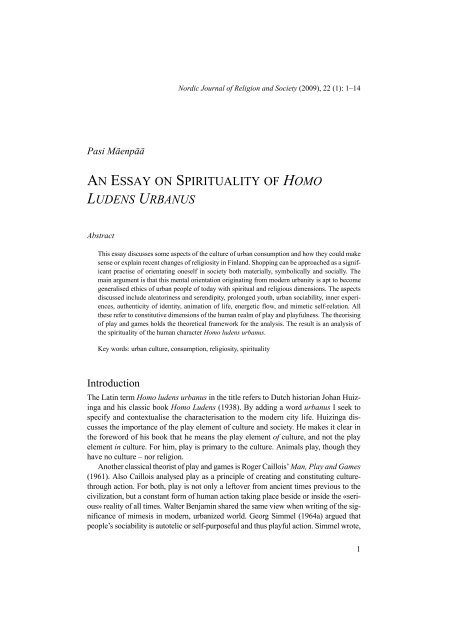
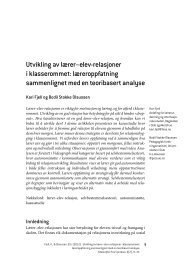
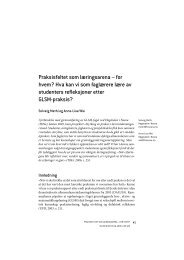
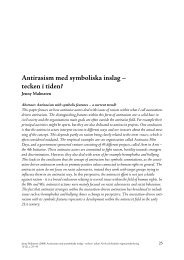
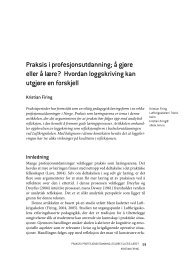
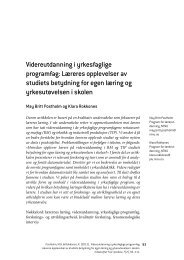
![Hvordan skal jeg […] utvikle meg selv? - Tapir akademisk forlag](https://img.yumpu.com/47976067/1/184x260/hvordan-skal-jeg-utvikle-meg-selv-tapir-akademisk-forlag.jpg?quality=85)
